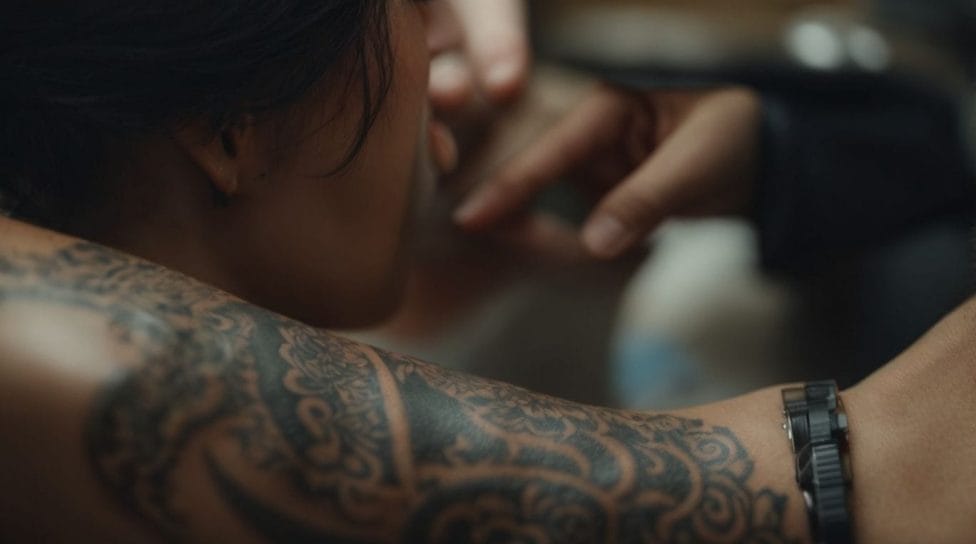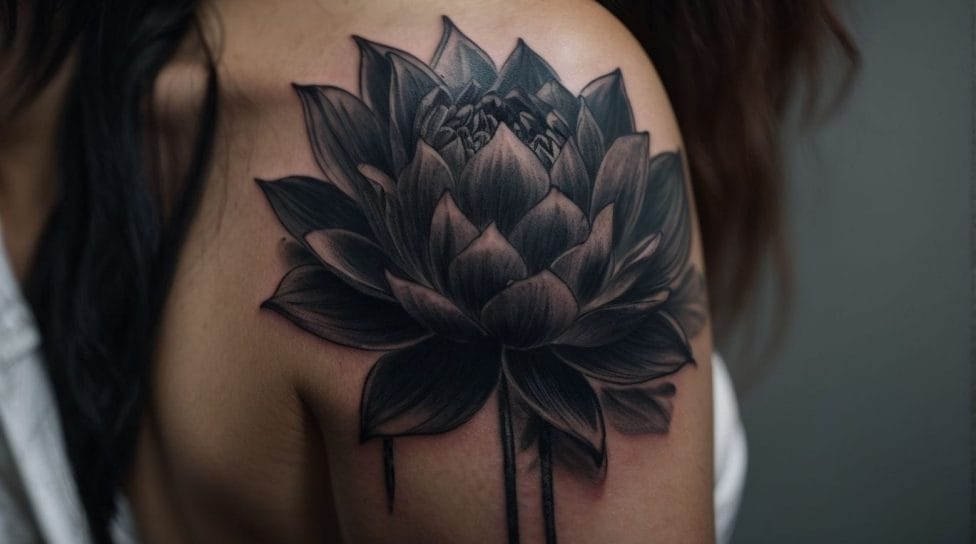Getting a tattoo is a personal and artistic expression that many people choose to adorn their bodies with. However, one common question that arises is, “Do tattoos hurt?”
The perception of pain can vary from person to person, and several factors determine the level of pain experienced during a tattooing session.
Understanding these factors and managing tattoo pain can help individuals make informed decisions about their body art. Here’s a breakdown of the main considerations when it comes to tattoo pain.
When it comes to tattoo pain, several factors play a role:
The location of the tattoo on the body can significantly impact the level of pain felt. Body areas with more nerve endings or thinner skin tend to be more sensitive.
Each person’s skin sensitivity varies, and some individuals may naturally have more sensitive skin than others. This can influence how much discomfort is felt during the tattooing process.
The size and complexity of the tattoo design can affect the duration of the session. Larger and more detailed tattoos may take longer to complete, leading to prolonged exposure to the tattoo needle.
The experience and skill of the tattoo artist can make a difference in the level of pain experienced. A skilled artist with a lighter touch may be able to minimize discomfort.
The sensation of getting a tattoo is often described as a combination of vibrations, stinging, and scratching. While some individuals may find this sensation uncomfortable, others may find it more bearable or even tolerable.
The tattoo needle punctures the skin’s top layers, causing a slight to moderate amount of pain. Some people compare the feeling to a continuous cat scratch or a repeated bee sting.
However, it’s important to note that the pain is usually temporary and subsides once the tattoo is complete.
While pain is subjective and everyone’s tolerance level varies, there are several methods individuals can use to manage tattoo pain:
Applying a topical numbing cream to the tattoo area before the session can help reduce discomfort.
Communicating with the tattoo artist and taking short breaks during the session can provide relief and allow individuals to manage their pain levels.
Practicing deep breathing or other relaxation techniques can help individuals stay calm and manage any discomfort they may experience.
Bringing along music, podcasts or engaging in conversation with the tattoo artist can divert attention from the pain and make the experience more enjoyable.
There are several misconceptions surrounding tattoo pain that can cause unnecessary worry or misunderstanding. It’s important to separate fact from fiction:
While tattoos involve some degree of discomfort, pain tolerance varies from person to person. Not all tattoos are excruciatingly painful.
Conversely, some individuals may believe that getting a tattoo is entirely painless. While it may not be unbearable, it is not entirely pain-free.
The pain experienced during the tattoo process is temporary and typically subsides shortly after the session. Once the skin heals, any residual soreness should dissipate.
Understanding the factors that contribute to tattoo pain and adopting strategies to manage discomfort can help individuals approach the tattooing process with a better understanding and make their experience as comfortable as possible.
Key takeaways:
- Tattoo pain varies based on factors such as placement, skin sensitivity, and complexity. The experience and skill of the tattoo artist also impact the level of pain.
- The sensation of getting a tattoo can range from discomfort to intense pain, but it is generally manageable with techniques like using numbing creams, taking breaks, and practicing relaxation techniques.
- There are common misconceptions about tattoo pain, including the belief that tattoos are always extremely painful, cause no pain at all, or that the pain will last forever. These misconceptions may deter people from getting tattoos.
What Factors Determine Tattoo Pain?

Photo Credits: Tattooineplanet.Com by Tyler Wilson
Are you curious about the factors that determine tattoo pain? Delve with me into the realm of tattooing as we explore the different elements that contribute to how much a tattoo hurts. From the placement on your body to the sensitivity of your skin, the size and complexity of the tattoo design, and even the experience and skill of the tattoo artist involved. Let’s uncover the various aspects that can make a tattoo session more or less painful.
Placement
“`
| Factors | Pain Level |
| Placement on areas with more nerve endings | Higher pain |
| Placement on fatty areas with fewer nerve endings | Lower pain |
| Placement on bonier areas with less padding | Higher pain |
When considering tattoo placement, it’s essential to take into account the sensitivity of the area and the amount of padding between the skin and bones. Areas with more nerve endings, such as the ribs or inner thighs, tend to be more painful. Conversely, fatty areas like the thighs or upper arms are generally less painful due to fewer nerve endings. Bony areas like the ankles or collarbones can also be more uncomfortable. Ultimately, the pain experienced during a tattoo will vary depending on individual pain tolerance.
Skin Sensitivity
Skin sensitivity is a critical factor to take into account when receiving a tattoo. Individuals with sensitive skin may encounter increased pain and discomfort throughout the tattooing process. This is because sensitive skin tends to react more intensely to stimuli, such as the introduction of ink into the skin. It is crucial to communicate your skin sensitivity to the tattoo artist beforehand so that they can modify their technique if necessary or suggest specific products to alleviate pain. Additionally, taking measures to care for your sensitive skin prior to and after getting a tattoo can contribute to proper healing and diminish potential irritation.
Tattoo Size and Complexity
The size and complexity of a tattoo are two key factors that significantly influence the level of pain one may experience during the tattooing process. When it comes to tattoo size, a larger tattoo area typically translates to more time spent with the needle, consequently resulting in increased discomfort. In a similar vein, intricate designs featuring fine lines and shading may elicit more pain compared to simpler, bolder designs. To ensure a smooth and comfortable experience, it is crucial to openly communicate your pain tolerance and expectations with your tattoo artist beforehand. Additionally, incorporating techniques such as applying numbing cream or taking breaks during longer sessions can assist in effectively managing the pain.
Experience and Skill of the Tattoo Artist
The experience and skill of the tattoo artist are crucial factors to consider when getting a tattoo. It is important to look for an artist who has a proven track record of successful tattoos and positive reviews from clients, showcasing their expertise. Additionally, examining the artist’s portfolio is essential to ensure that their style aligns with your vision and that they have experience with the type of tattoo you want, further highlighting their skill. A skilled artist will also have a steady hand, precise linework, and the ability to create detailed and intricate designs, showcasing their technique. Moreover, confirming that the artist follows strict hygiene protocols is imperative to reduce the risk of infection, emphasizing their commitment to sanitary practices. Lastly, a professional artist will listen to your ideas, provide guidance, and ensure your comfort throughout the tattooing process, emphasizing the importance of communication.
What Does Getting a Tattoo Feel Like?

Photo Credits: Tattooineplanet.Com by Ralph Gonzalez
Curious about the sensation of getting a tattoo? Brace yourself for an exhilarating ride as we dive into the world of experiencing ink on your skin. From the prickling sensation of the needle penetrating your epidermis to the mesmerizing buzz that accompanies the tattoo machine, we’ll explore the diverse array of feelings that come with getting inked. So, buckle up and get ready to uncover the captivating world of tattoo sensations.
Description of Sensations
Getting a tattoo can elicit a variety of sensations depending on individual factors, such as pain tolerance and placement. Commonly described sensations include a scratching or stinging feeling, similar to repeated bee stings or sunburn, during the tattooing process. Some people also experience a dull ache or throbbing sensation afterward as the tattoo heals. It’s important to note that pain levels can vary for each person and are subjective. To manage tattoo pain, consider using numbing creams, taking breaks during the session, practicing deep breathing or relaxation techniques, and finding ways to distract yourself. Remember, everyone’s tattoo experience and pain tolerance are different, so it’s best to consult with your tattoo artist for a personalized description of sensations and their recommendations.
How to Manage Tattoo Pain

Photo Credits: Tattooineplanet.Com by James Davis
Discover how to manage tattoo pain like a pro with these effective techniques. From the benefits of tattoo numbing creams to the power of taking breaks, deep breathing, relaxation techniques, and even distracting yourself, this section will reveal the secrets to minimizing discomfort during the tattooing process. Learn how to make your tattoo experience a more comfortable and enjoyable one, backed by proven methods and expert advice. Say goodbye to unnecessary pain and embrace the art of pain management in tattooing.
Tattoo Numbing Creams
Tattoo-numbing creams are an excellent way to manage pain throughout the tattooing process. There are several options available that you can consider:
- EMLA Cream: This cream contains lidocaine and prilocaine, which effectively numb the skin.
- Numb520: For a powerful numbing effect, Numb520 contains 5% lidocaine.
- Hush Gel: By combining lidocaine with botanical extracts, Hush Gel provides effective pain relief.
- Tattoo Soothe: This cream contains all-natural ingredients like aloe vera, which soothes and numbs the skin.
- Gigi Hidrosoluble Numbing Spray: If you prefer a spray-on option for quick and easy application, Gigi Hidrosoluble Numbing Spray is a great choice.
Using tattoo-numbing creams is a fantastic way to make the tattooing experience more comfortable. However, it’s crucial to carefully follow the instructions and consult with your tattoo artist to ensure that the creams do not interfere with the tattooing process.
In a fascinating historical incident, tattooing was not always accompanied by numbing creams. In ancient times, certain cultures relied on ice or numbing herbs to alleviate the pain during tattooing. Fortunately, advancements in technology have made tattoo-numbing creams easily accessible today, enabling individuals to enjoy a more comfortable tattoo experience.
Taking Breaks
Taking breaks during the tattooing process can greatly help manage pain and discomfort. Here are some steps to consider:
- Communicate with your tattoo artist and let them know if you need a break.
- Plan breaks in advance, especially for longer tattoo sessions.
- During breaks, find a comfortable position and relax your body and mind.
- Engage in deep breathing exercises to help calm your nerves.
- Distract yourself by listening to music, watching a movie, or talking to a friend.
- Stay hydrated and have a light snack to maintain your energy levels.
Remember, taking breaks doesn’t mean you’re weak. It can actually help you endure the tattoo process better and ensure a more positive experience.
Deep Breathing and Relaxation Techniques
Incorporate deep breathing and relaxation techniques: Inhale deeply through your nose and exhale slowly through your mouth as you manage tattoo pain. This will help you relax your body and make the experience more bearable.
For more information on Do Tattoos Hurt? Visit this reputed source.
Focus on utilizing relaxation techniques to ease your muscles: Start from your toes and consciously relax each muscle group as you move upwards. This will contribute to a more relaxed state during the tattooing process.
Practice mindfulness to manage pain: Stay present in the moment and be aware of the sensations without judgment. Incorporating deep breathing and relaxation techniques can reduce anxiety and pain perception.
Utilize visualization methods: Visualize yourself in a tranquil place or imagine the pain easing away with each breath you take. This technique can assist in managing the tattoo pain.
Enhance your experience by listening to calming music or guided meditations: Playing soothing sounds can create a serene environment and distract your attention from the pain. Combine these techniques with deep breathing and relaxation for maximum effect.
Distracting Yourself
- Distracting yourself is a helpful technique to manage tattoo pain. Here are some steps to do so:
- Listen to music or podcasts: Focus on the soothing sounds to divert your attention.
- Talk to the tattoo artist: Engaging in conversation can divert your focus from the pain.
- Breathing exercises: Deep breathing can calm your mind and help you relax during the process.
- Visualize a happy place: Imagine yourself in a peaceful setting to distract from the discomfort.
Fun Fact: Distracting yourself techniques, like counting or solving puzzles, activate the brain’s pain-relieving pathways, reducing the perceived pain sensation.
Common Misconceptions About Tattoo Pain

Photo Credits: Tattooineplanet.Com by Richard White
When it comes to tattoo pain, some common misconceptions need to be debunked. Let’s uncover the truth behind these beliefs and separate fact from fiction. In this section, we’ll explore three sub-sections that address various aspects of tattoo pain, including the belief that tattoos are always extremely painful, the perception that tattoos don’t cause any pain at all, and the misconception that tattoo pain lasts forever. Get ready to reevaluate what you thought you knew about tattoo pain!
Tattoos Are Always Extremely Painful
Getting a tattoo is not always extremely painful, as the level of pain can vary based on different factors. Here are some important points to consider when it comes to tattoo pain:
- Placement: Certain areas of the body are more sensitive than others, so pain levels will vary depending on where you get tattooed.
- Skin Sensitivity: Some individuals have more sensitive skin, which can make the tattooing process feel more uncomfortable.
- Tattoo Size and Complexity: Larger and more intricate tattoos may take longer to complete, potentially causing more discomfort.
- Experience and Skill of the Tattoo Artist: A skilled artist can minimize pain by using proper techniques and adjusting their approach based on the client’s comfort level.
Remember, everyone’s pain tolerance is different, so what may be uncomfortable for one person may be manageable for another. It’s important to consult with your tattoo artist and openly communicate your concerns about pain during the tattooing process.
Tattoos Don’t Cause Any Pain
Many people believe that tattoos don’t cause any pain, but this is a common misconception. While everyone’s pain tolerance is different, getting a tattoo typically involves some level of discomfort. The pain can range from a mild stinging sensation to a more intense feeling, depending on factors like placement, skin sensitivity, and the size and complexity of the tattoo. It’s important to manage tattoo pain effectively by using numbing creams, taking breaks during the process, practicing deep breathing and relaxation techniques, and finding ways to distract yourself. Remember, pain is subjective, and what one person may find painful, another may not.
True story:
When Sarah got her first tattoo, she was convinced it wouldn’t hurt at all. As soon as the needle touched her skin, she realized that tattoos do cause pain. Despite the discomfort, she managed to get through it by practicing deep breathing and focusing on the result. Sarah now proudly shows off her tattoo and admits that although it hurt, the experience was worth it.
Tattoo Pain Lasts Forever
Tattoo pain does not last forever, as the actual pain experienced during the tattooing process is temporary. There are a few factors to consider regarding potential discomfort or long-term effects.
- Healing process: After getting a tattoo, there may be some discomfort during the healing process, which can last for a few weeks. This is a normal part of the tattooing process and varies from person to person.
- Tattoo placement: Certain areas of the body are more sensitive than others, so the pain experienced during the tattooing process may vary depending on the location.
- Tattoo size and complexity: Larger and more intricate tattoos may take longer to complete, potentially resulting in more discomfort.
- Tattoo artist skill: A skilled and experienced tattoo artist can help minimize discomfort by using proper techniques and working efficiently.
Remember, the pain of getting a tattoo is temporary, and it’s important to follow proper aftercare instructions to ensure a healthy healing process.
Some Facts About “Do Tattoos Hurt?”:
- ✅ Getting a tattoo involves pain, but the level of pain varies depending on multiple factors. (Source: Our Team)
- ✅ pain during a tattoo session can be influenced by factors such as the size and placement of the tattoo. (Source: Our Team)
- ✅ Areas close to bones or with high nerve concentrations tend to be more painful when tattooed. (Source: Our Team)
- ✅ The size of the tattoo affects the pain level, with larger tattoos generally being more painful. (Source: Our Team)
- ✅ Personal pain tolerance varies, and everyone’s experience with pain during a tattoo is different. (Source: Our Team)


